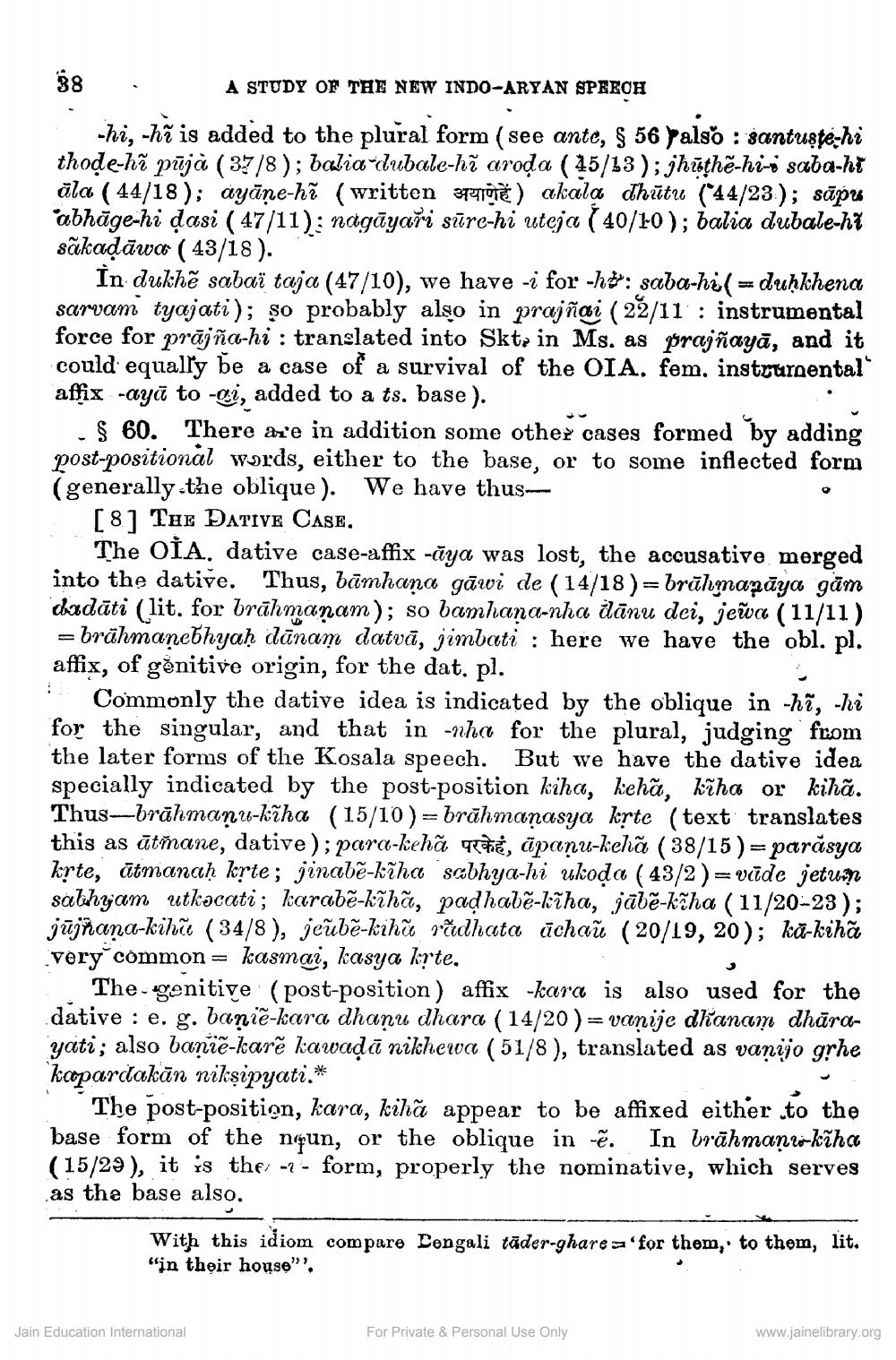________________
38 .
A STUDY OF THE NEW INDO-ARYAN SPEECH -hi, chã is added to the plural form (see ante, $ 56 yalso : santustė:hi thode-hã pūjà (37/8); balia dubale-hž aroda (45/13); jhűthe-hi-ý saba-ht äla ( 44/18); ayāne-hã (written 3710TÉ) akala dhūtu (44/23); sāpu abhāge-hi dasi ( 47/11); nagāyari sūre-hi uteja (40/10); balia dubale-ht sākaļāwo ( 43/18).
În dukhẽ sabaï taja (47/10), we have -¿ for -ht: saba-hi( = duḥkhena sarvam tyajati); so probably also in prajñai (22/11 : instrumental force for prājña-hi : translated into Skta in Ms. as prajñayā, and it could equally be a case of a survival of the OIA. fem. instrurnental affix -ayā to mai, added to a ts. base).
60. There are in addition some other cases formed by adding post-positional words, either to the base, or to some inflected form (generally the oblique). We have thus
[8] THE DATIVE Case.
The OÌA, dative case-affix -aya was lost, the accusative merged into the dative. Thus, bāmhana gāwi de (14/18)=brāhmapāya gām cxdāti (lit. for brāhmaṇam); so bamhana-nha dānu dei, jeña (11/11)
= brähmanebhyaḥ dānam datvā, jimbati : here we have the obl. pl. affix, of gěnitive origin, for the dat. pl.
Commonly the dative idea is indicated by the oblique in hi, hi for the singular, and that in nha for the plural, judging from the later forms of the Kosala speech. But we have the dative idea specially indicated by the post-position kiha, kehã, kiha or kihã. Thus-brāhmaṇz-kīha (15/10 )= brāhmaṇasya krte (text translates this as ātñnane, dative); para-kehã o , āpaņu-kelã (38/15)= parăsya krte, ātmanaḥ krte; jinabe-kiha sabhya-hi ukoda ( 43/2)=vide jetuan sathyam utkacati ; karabé-kihã, padhabe-kiha, jābē-kīha (11/20-23); jūjñana-kihữe ( 34/8), jeūbē-kihữ rădhata ūchał (20/19, 20); kā-kihã very common = kasmai, kasya krte.
The genitive (post-position) affix -kara is also used for the dative : e. g. baniê-kara dhanu dhara (14/20 )= vanije dhanam dhārayati; also bañüê-karę kawaļā nikhewa (51/8), translated as vanijo grhe koopardakān niksipyati.*
The post-position, kara, kihã appear to be affixed either to the base form of the noun, or the oblique in ē. In brähmana-kīha (15/29), it is the: -2 - form, properly the nominative, which serves as the base also.
With this idiom compare Dengali tāder-ghare='for them, to thom, lit. "in their house".
Jain Education International
For Private & Personal Use Only
www.jainelibrary.org




